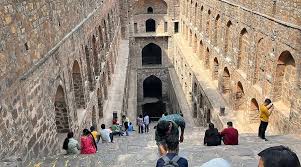Rajon ki Baoli:

The Archaeological Survey of India (ASI), in collaboration with the World Monuments Fund India (WMFI) and the TCS Foundation, has successfully completed the conservation work of ‘Rajon ki Baoli’, a 16th-century stepwell.
- Rajon ki Baoli, also known as Rajon ki Bain, is a significant historical stepwell located in south Delhi’s Mehrauli Archaeological Park.
- It was built in 1506 CE by Daulat Khan during the reign of Sikander Lodi, of the Lodi dynasty, which was the last pre-Mughal dynasty in India.
- It stands as a testament to Lodi-era architecture and traditional water engineering.
- It was used in its time as a water reservoir and a retreat during summers.
- The stepwell’s name, Rajon ki Baoli, translates to ‘Baoli of the Masons,’ reflecting its historical use by masons for drinking and cooking purposes.
- The stepwell is primarily subterranean, with only the topmost storey visible above ground.
- Its structure is built in four levels, each narrowing down as one approaches the well in the bottom.
- Spanning across an area of 1,610 square metres, this baoli descends to a depth of 13.4 metres, with the main tank measuring 23 by 10 metres at its base.
- It is a fine example of Indo-Islamic architecture, featuring intricate stone carvings, ornate arches, and a functional design that provided a natural respite from the heat.




